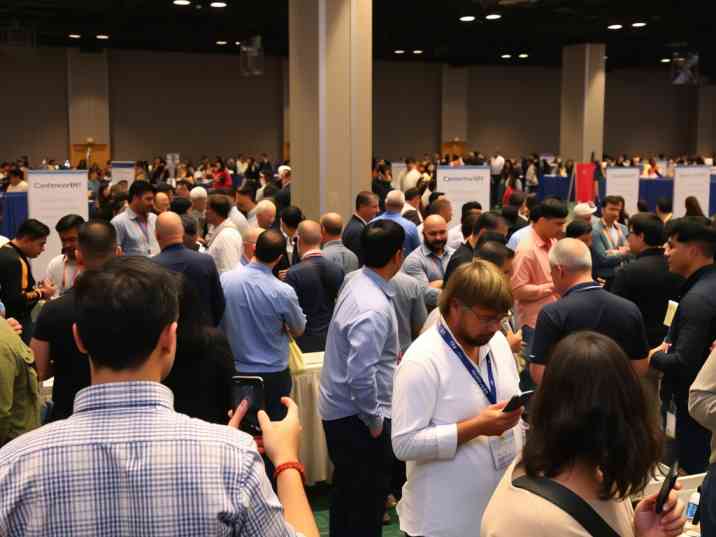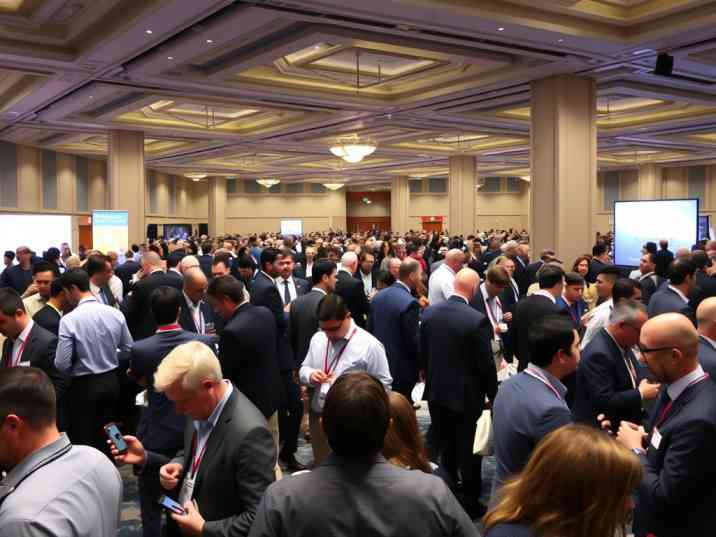In today’s digital age, where connectivity is as essential as oxygen for many professionals, conferences and events are no longer just about delivering presentations or networking in person. Attendees expect seamless access to information, real-time engagement opportunities, and personalized experiences that align with their professional goals. This is where WiFi marketing emerges as a game-changer for conference organizers. By leveraging the power of WiFi networks, event planners can create immersive, data-driven experiences that not only enhance attendee satisfaction but also drive measurable business outcomes.
WiFi marketing involves using a venue’s wireless internet connection as a tool to collect valuable insights, deliver targeted content, and foster meaningful interactions between attendees, sponsors, and organizers. It goes beyond simply providing free internet access—it transforms WiFi into an interactive platform that amplifies engagement at every stage of the event lifecycle. In this article, we will explore why conferences need WiFi marketing to engage attendees effectively, examining its benefits, implementation strategies, and long-term impact on event success.
1. Enhancing Attendee Experience Through Seamless Connectivity
One of the primary reasons conferences require robust WiFi infrastructure is the growing demand for constant connectivity among attendees. Modern professionals rely heavily on mobile devices, laptops, and tablets to stay productive, informed, and socially connected during events. Without reliable WiFi, even the most well-planned conference risks alienating participants who may struggle to access online resources, participate in live polls, or share updates on social media.
The Role of WiFi Marketing
WiFi marketing takes connectivity a step further by offering more than just basic internet access. When attendees log into the event’s WiFi network, they are greeted with branded splash pages, surveys, or promotional offers tailored to their interests. For instance, a healthcare conference might display relevant industry news or sponsor advertisements on the login page, creating immediate value for users while reinforcing brand messaging.
Moreover, high-speed WiFi enables attendees to stream live sessions, download presentation materials, and collaborate virtually with peers—all of which contribute to a richer, more engaging experience. By ensuring uninterrupted connectivity, organizers demonstrate their commitment to meeting attendee expectations and fostering a tech-savvy environment.

2. Capturing Valuable Data for Personalization
Data has become the cornerstone of modern marketing strategies, and conferences are no exception. Traditional methods of gathering attendee feedback, such as post-event surveys or manual sign-in sheets, often yield limited results due to low response rates and incomplete information. WiFi marketing addresses these challenges by automating data collection processes through smart analytics tools embedded within the network.
How It Works
When attendees connect to the conference WiFi, they typically provide some form of identification, such as an email address or social media credentials. This simple act opens the door to a wealth of demographic and behavioral data, including:
- Device type : Understanding whether attendees use smartphones, laptops, or tablets helps optimize digital content delivery.
- Session attendance patterns : Tracking which sessions attendees join provides insights into popular topics and areas of interest.
- Engagement metrics : Analyzing how long attendees remain connected and what actions they take (e.g., visiting sponsor websites) reveals engagement levels.
By aggregating this data, organizers can segment audiences based on preferences and behaviors, enabling them to deliver hyper-personalized communications both during and after the event. For example, attendees interested in AI technology could receive follow-up emails featuring related webinars or whitepapers, nurturing leads and building stronger relationships over time.
3. Driving Sponsorship Revenue Through Targeted Advertising
Sponsors play a critical role in funding conferences, yet many struggle to measure the ROI of their investments. Traditional sponsorship models often focus on static banners or booth placements, which fail to capture the attention of busy attendees navigating crowded exhibition halls. WiFi marketing offers a dynamic solution by integrating targeted advertising directly into the attendee journey.
Benefits for Sponsors
With WiFi marketing, sponsors gain unprecedented visibility and control over how their messages reach potential customers. For instance:
- Splash page promotions : Sponsors can feature exclusive discounts, product demos, or lead magnets on the WiFi login screen, capturing attention at the moment of connection.
- Geo-targeted notifications : Using geofencing technology, organizers can send push notifications to attendees near specific booths or stages, encouraging foot traffic and boosting sponsor exposure.
- Post-event retargeting : Collected data allows sponsors to continue engaging prospects via email campaigns or social media ads, extending the lifespan of their investment.
These capabilities not only increase the perceived value of sponsorships but also enable organizers to charge premium rates for enhanced visibility options. As a result, WiFi marketing creates a win-win scenario for all stakeholders involved.
4. Facilitating Real-Time Engagement and Interaction
The success of any conference hinges on its ability to facilitate meaningful interactions between attendees, speakers, and exhibitors. While traditional Q&A sessions and networking breaks serve their purpose, WiFi marketing introduces innovative ways to foster real-time engagement throughout the event.
Interactive Features Enabled by WiFi
Modern event apps powered by WiFi networks allow attendees to:
- Participate in live polls and quizzes : Speakers can gauge audience sentiment instantly, tailoring their presentations to address key concerns or spark discussions.
- Access digital agendas and maps : Dynamic scheduling tools help attendees navigate complex programs efficiently, reducing confusion and maximizing participation.
- Network digitally : Virtual matchmaking platforms analyze attendee profiles to suggest relevant connections, breaking down barriers for introverted individuals or first-time attendees.
Additionally, gamification elements like scavenger hunts or leaderboard competitions incentivize exploration and interaction, keeping energy levels high throughout the day. These features not only enhance attendee satisfaction but also generate buzzworthy moments that amplify word-of-mouth promotion.
5. Strengthening Post-Event Relationships
A common pitfall of traditional conferences is the lack of sustained engagement once the event concludes. Attendees return to their daily routines, and valuable connections made during the conference often fade without proper follow-up. WiFi marketing bridges this gap by facilitating ongoing communication and community-building efforts.
Leveraging Post-Event Data
After the conference, organizers can use the data collected through WiFi marketing to nurture leads and maintain momentum. Examples include:
- Sending personalized thank-you emails with links to recorded sessions or additional resources.
- Inviting attendees to join exclusive LinkedIn groups or Slack channels dedicated to continued learning and collaboration.
- Offering early-bird registration discounts for future events to encourage repeat attendance.
Furthermore, sponsors benefit from access to qualified leads generated during the event, allowing them to pursue sales opportunities proactively. By transforming one-time attendees into loyal advocates, WiFi marketing ensures that the impact of your conference extends far beyond its closing remarks.

6. Overcoming Implementation Challenges
While the advantages of WiFi marketing are clear, implementing it successfully requires careful planning and execution. Organizers must address potential hurdles such as technical limitations, privacy concerns, and budget constraints to maximize ROI.
Key Considerations
- Scalability : Ensure the WiFi infrastructure can handle peak loads, especially for large-scale conferences with thousands of simultaneous users.
- Security : Implement robust encryption protocols and comply with data protection regulations (e.g., GDPR) to safeguard attendee information.
- User Experience : Simplify the login process by supporting multiple authentication methods, such as social media accounts or QR codes.
- Cost Management : Partner with reliable vendors who offer flexible pricing plans and scalable solutions to accommodate varying event sizes.
By addressing these factors upfront, organizers can build trust with attendees while minimizing disruptions caused by technical issues.
Conclusion
In an era defined by digital transformation, conferences must evolve to meet the changing needs of modern attendees. WiFi marketing represents a powerful opportunity to elevate the attendee experience, unlock actionable insights, and drive sustainable growth for organizers and sponsors alike. From enhancing connectivity and personalizing interactions to boosting sponsorship revenue and fostering long-term relationships, the benefits of WiFi marketing are undeniable.
As competition among events intensifies, adopting innovative technologies like WiFi marketing is no longer optional—it’s essential. By embracing this strategy, conference organizers can position themselves as leaders in the industry, delivering unparalleled value to attendees while achieving their own business objectives. The question is no longer if you should invest in WiFi marketing—it’s how soon you can get started.






